“Sahab, they came in a boat. They gave us biscuits and matchboxes and said they would bring food packets shortly. It’s been three days since then, no one has arrived. We are running short of water,” said Umesh Malli, a resident of Sitamarhi district in Bihar.
“Our homes got washed away. Some people rescued us. Since then we have been living in a school,” he added.
The state has been grappling with floods and it’s after effects since past few days and the death toll has reached 130. The Sitamarhi district, where Malli lives, is the worst affected and has reported the most number of casualties. Twelve districts of North-East Bihar have still not recovered. As of July 24, more than 81 lakh people are still marooned, according to official figures.
The government did its bit by opening community kitchens and setting up relief camps but why the help didn’t reach many. Picture this. As per the data released by the government, as of July 24, 14 lakh and 17 lakh people were affected in Madhubani and Sitamarhi respectively. However, no relief camp was set up in Madhubani, while only 39 relief camps were set up in Sitamarhi. A total of 67 people died in these two districts alone.
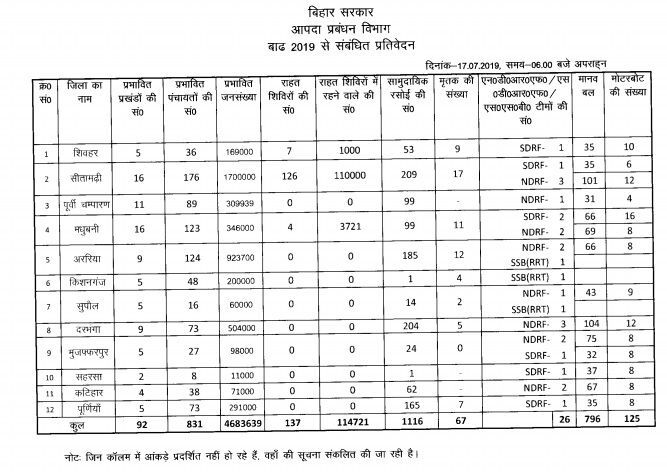
Similarly, 835 community kitchens were set up for the flood-affected in 12 districts comprising 105 blocks and 1,240 panchayats. This means, there was one community kitchen for more than 7,000 people.
Even though the government claims it has done its bit by providing help to the flood affected, the ground reality is quite different because as per official figures, 81 lakh people were marooned last month, but more than 60 lakh people couldn’t find a place in any relief camps, because there were none.
The Department of Disaster Management in Bihar published a report every day which gave an overview of the flood situation in the state and rehabilitation activities. It mentioned that between July 16 and July 17, while the number of flood victims increased from 26 lakh to 46 lakh, the number of relief camps went down from 185 to 137.
They kept looking for relief camps post flash floods
When Gaon Connection reporters reached Bisfi block in Madhubani district, a local resident, Mohammad Nisar, who had been living on the terrace of his home along with his livestock from three days, mistook them for government officials and came running to them seeking help.
An angry Nisar said, “You are the first ones to reach here. We didn’t get any help from the government. We were informed that relief camps were set up, khichadi was being distributed in the community kitchens, but we could not find any camps of kitchens because there were none.”
He added: “The flood hit the state in 2017. This year too there were possibilities. But no one informed us beforehand.”
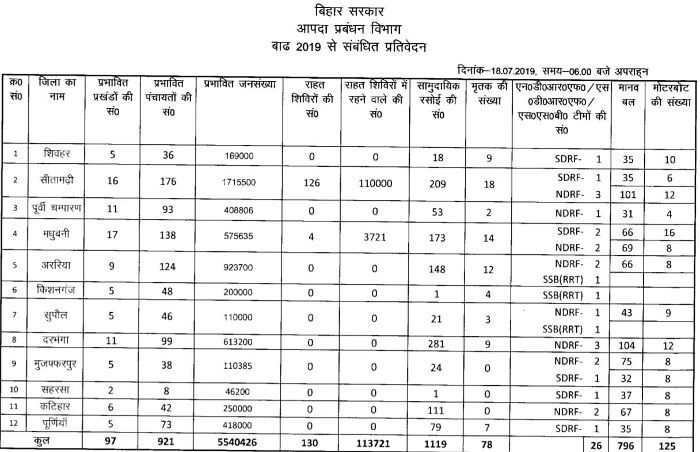
“No learning”
“What did we learn from the 2017 floods,” asks Ritu Jaiswal, mukhiya of Gram Panchayat in Raj Singhwahini village in Sitamarhi district.
“The government wasn’t prepared. It failed to provide help to all. For instance, they said they would provide food to only those who have taken shelter in government schools. Not all flood victims live near schools. Moreover, the officials ask them to collect food packets. All the roads connecting to villages had got washed away. How did they expect people to commute in such a scenario? Moreover, each school could accommodate only 20 people.”
According to the state Department of Disaster Management, by July 19, around 14 lakh people were affected due to flash floods in 18 blocks of Madhubani district. Despite that only four relief camps were set up in the district, which could provide shelter to only 3,721 people. The rest were struggling to survive.
When the sub-divisional magistrate (SDM) of Madhubani district, Durga Nand Jha, was contacted, he said: “People are lying. Those who have received help, they deny getting any help. It does not help us. Our team is working round the clock. Even they are exhausted.”
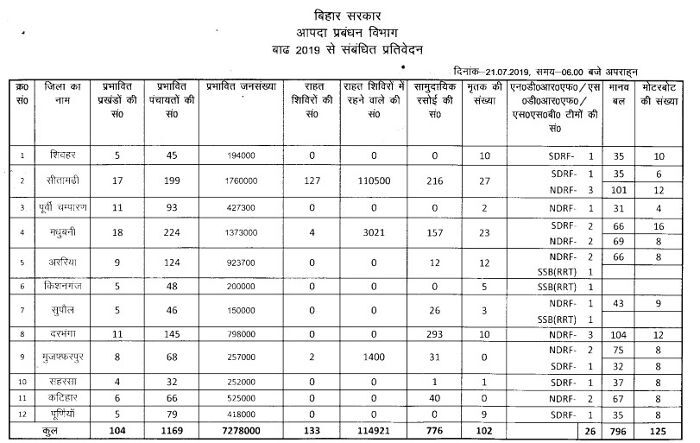
The number mismatch
In Sitamarhi, which was the worst-hit, around 17 lakh people living in 203 panchayats were affected by the flash floods, but only 39 relief camps were set up. By July 21, 127 relief camps were set up, but then 199 panchayats were affected and not 203. Soon after the floods, 216 community kitchens were set up, but when the number of flood-affected went up, there were only 197 community kitchens.
Umesh Malli, a resident of Laptaha village in Parihar block, Sitamarhi district, said:”My area was flooded on July 17. My home got washed away in floods. It hit us suddenly. I managed to save my mother and wife, but I lost all of my 20 pigs. We are living in a school. We are getting food to eat thanks to the villagers, but only once a day.”
As of July 21, there were only four relief camps in whole of Madhubani district when the total number of affected stood at 13 lakh. The very next day, July 22, when the number of flood-affected increased to 13,94,000, the data shows there were no relief camps in Madhubani.
Amod Kumar Sharan, joint secretary of disaster management in Bihar, said:”We did issue high alert in all the districts.We also provided all the possible help to the flood-affected. The relief camps stopped functioning only in those areas which had started recovering post floods.”
He added: “We will keep providing help to the flood affected.”
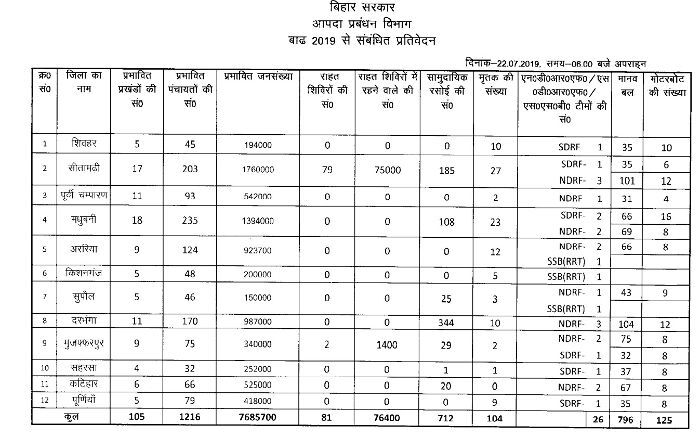
No answers
The closure of relief camps in flood-affected areas and decreasing community kitchen remains puzzling. The government may have some answers.
Naruar village in Jhanjharpur block of Madhubani district was badly hit. The Villagers living here said that when they call the authorities to ask for help, they don’t respond.
Rakesh Mandal, a resident of this village, said: “We were informed about the floods by the government. But even then, no preventive measures were taken. We kept on calling the National Disaster Response Force team and the district magistrate when water started gushing out of the dam. Neither responded. Eventually, at 11:30 pm, the dam collapsed.”
He added, “We stayed on our terrace all night. My grand-mother was swept away. We thought we lost her. She was found in a school the next day. The government relief team arrived at 3 pm the next day.”
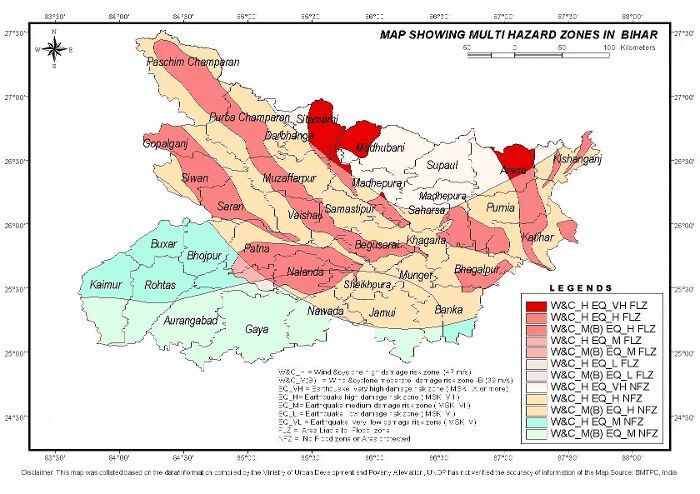
Floods a regular feature now
2017 floods are still fresh in people’s memories. When the floods have become a regular occurrence in Bihar, why does the government swing into action after the disaster strikes?
“All the 12 districts of Bihar are inundated, millions of people are affected, more than 100 are dead. The state, especially North Bihar, gets affected by floods every year. The state deals with floods and drought every year,” said Pushya Mitra, a senior reporter living in Bihar.
He added, “Like every year, on May 5, the state Department of Disaster Management alerted all the district magistrates from the flood-prone districts about the floods. They requested them to take necessary measures like strengthening embankments, alerting the NDRF and SDRF teams, making arrangements for boats, relief camps, control room, among others things. Instructions were given to evacuate those living in flood-prone districts.Adequate budget was provided for this.”
He added: “I am a common man yet I knew about flash floods on the evening of July 12. What did the authorities do? Did they issue any high alert? Did they evacuate people living in flood prone areas? Embankments on the Kamala Balan river collapsed at 10 places. Everyone knew about the weak embankment. Did anybody bother to fix it between May and July?”
Read Also in Hindi: बिहार बाढ़ ग्राउंड रिपोर्ट: ‘साहब लोग बिस्किट और माचिस दे गए थे, खाने का तीन दिन से इंतजार है’
Read Also: These students went out of their way to help the flood-affected in Bihar
Read Also: Do embankments cause floods or prevent floods? Experts are divided




















